Where the New Year is lonely wanderers of the universe
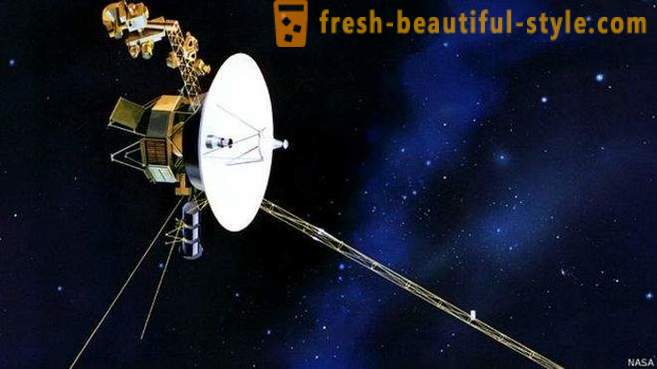
Many of us will spend the New Year holidays away from family and friends, but the correspondent of BBC Future offers to remember the most lonely representative of humanity - spacecraft that humans started to study objects in the solar system and beyond.
In July 1965 the US probe "Mariner" became the first spacecraft transmitted to Earth Mars photos. Today, almost 50 years on the Martian orbit are several stations on the surface of the planet two rovers work, and in the world are preparing for the start of the new interplanetary missions.
Orbital stations are studying Mercury, Venus and Saturn. One lander explores the surface of the comet and the other - the surface of the moon of a distant planet. Not to mention the variety of space telescopes peering into the depths of the universe.
The Christmas and New Year is the time to remember the distant friends. Let's think about those who are in these days working in the name of science away from the Earth, helping us to better understand the structure of the universe. Here are 12 research programs, arranged in ascending order according to the time elapsed since the start (all distances are approximate):
A probe "Hayabusa-2" (Hayabusa 2)
Distance from Earth: recently left Earth orbit
The time elapsed since the start of 3 weeks
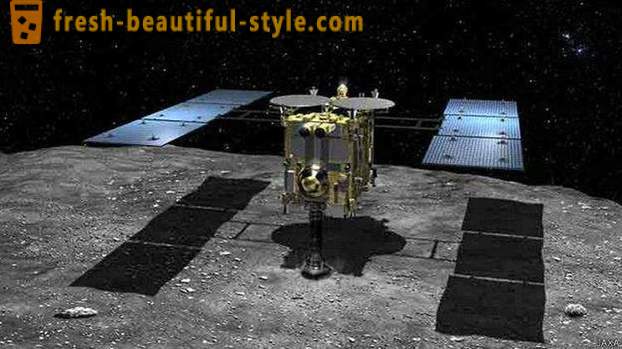
The Japanese unit "Hayabusa-2" flew to the asteroid, but must return to Earth
Japan's space agency - the world leader in the field of asteroid studies. In 2010, the first interplanetary station series "Hayabusa" will return to Earth with soil samples of asteroid Itokawa.
The task of the unit 'Hayabusa-2 ", launched December 3, 2014 - to get close to another asteroid and obtain from the surface soil samples using a small mobile device. Unlike other expeditions listed in our list, the mission of "Hayabusa-2" is intended to return the unit to the ground. Or at least part of it.
Telescope "Gaia" (Gaia)
The distance from the earth 1, 5 million kilometers
The time elapsed since the start: 12 months
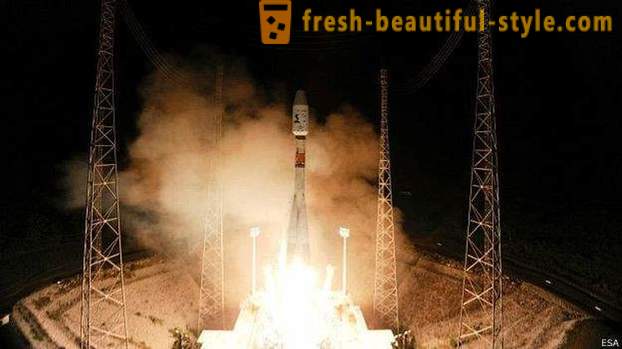
Telescope "Gaia" of the European Space Agency will create a three-dimensional map of our Galaxy
To achieve an ideal environment for observation of space objects should be placed in one of the observatory five Lagrange points, or points libration in which the gravitational forces of the sun and earth mutually cancel each other, allowing the apparatus to remain stationary with respect to the two celestial bodies. In one of these points, known as L2, at a distance of one and a half million kilometers from Earth, the telescope is currently the European Space Agency (ESA) "Gaia", whose main task - to create a detailed three-dimensional map of our Galaxy.
"Gaia" - the largest to date, the orbital telescope. It measures and maps the location, movement parameters and change the brightness of each of the stars of the Milky Way. In addition, it is expected that the device will detect previously unknown planets, asteroids and supernovae.
The orbiter MAVEN
The distance from Earth: 225 million kilometers
The time elapsed since the start: 13 months
MAVEN will help you understand how to change the climate of Mars, and what happened with the atmosphere of the red planet
Any of the expeditions to Mars - the second level of study of the planet of the solar system after the Earth - deserves special mention. But MAVEN (acronym from the English Mars Atmosphere and Volatile EvolutioN, or "the atmosphere and evolution of volatiles on Mars") stands alone. This orbiter US space agency NASA aims to find an answer to the fundamental question of modern astronomy - what happened to the atmosphere of the Red Planet?
Scientists are getting more evidence that millions of years ago the climate on Mars was warmer and wetter, and the planet was surrounded by a thick layer of the atmosphere. On the surface of Mars contained water, which is a prerequisite for the emergence of life. By studying the remains of the Martian atmosphere, MAVEN will help researchers determine the cause of climate change on this planet.
The lunar orbiter (Lunar Reconnaissance Orbiter, LRO)
The distance from the Earth 384 400 km
The time elapsed since the start: 5 years 6 months

orbiter, NASA continues to explore the Moon, which began in the "Apollo" program
Perhaps you think that after the last manned mission to the moon in the "Apollo" program in December 1972, NASA lost interest in our satellite. In fact, the moon is never deleted from the plan of space exploration. On the contrary, in the course of a number of already implemented and planned lunar missions, scientists expect to clarify many questions left unanswered after flying ships "Apollo".
The @ LRO @ apparatus, which is in lunar orbit in 2009, be mapped the lunar surface with a previously unavailable level of detail. Recently, NASA researchers have suggested that craters with steep walls, the probe found, could be used as shelters participants for future manned missions to the moon.
The interplanetary station "New Horizons" (New Horizons)
The distance from Earth 4, 7 billion kilometers
The time elapsed since the start of 9 years
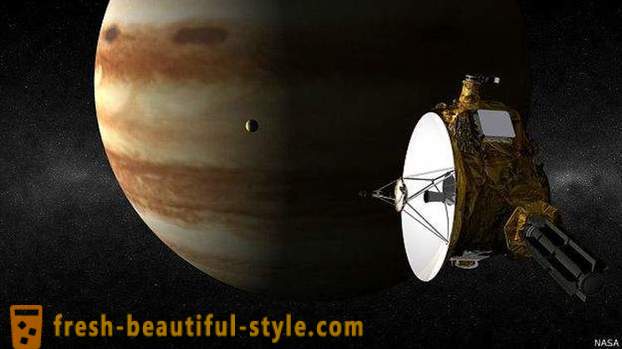
Station "New Horizons", justifying its name, is flying to the boundaries of the Solar System
Interplanetary probe, NASA "New Horizons", launched in January 2006, has recently once again came out of hibernation and prepares to study Pluto. Although Pluto officially lost its status as a planet, this is a celestial body is still of interest to science.
Pluto is now ranked as a dwarf planet within the Kuiper belt, which consists of a relatively small objects (mainly - frozen gases clusters). Station "New Horizons" Pluto closer to the minimum distance of 14 July 2015 With a wide range of scientific instruments on board, the machine will hold a detailed study of the planets and other objects in the Kuiper belt.
The space station "Venus-Express" (Venus Express)
The distance from the Earth 41, 9 million square kilometers
The time elapsed since the start of 9 years

solar flares almost put out of action station that explores and photographs Venus
All expedition ever completed, but the ESA orbiter "Venus Express" takes stamina wonders beyond the planned lifetime. The device was launched into orbit of Venus in 2006 with the purpose of studying its dense, atmospheric disturbances.
The expedition was to be completed last year. It was assumed that the device will be destroyed as a result of atmospheric maneuver, but "Venus Express" has survived and retained performance. As the board was still fuel for maneuvering, it was decided to continue the operation of the probe as long as it remains possible. However, given that the recent "Venus Express" switched to the so-called survival mode, time is not so much.
interplanetary probe "Messenger" (Messenger)
The distance from Earth: 77 million kilometers
The time elapsed since the start of 10 years 4 months
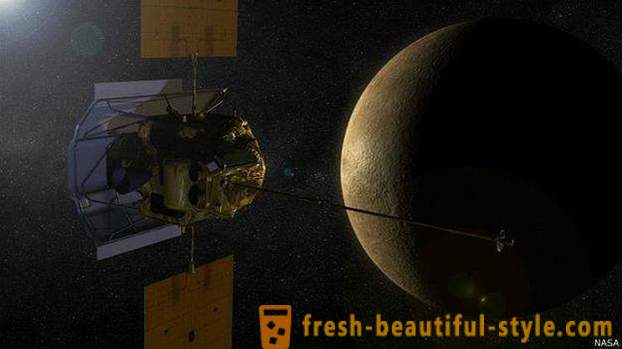
On the way to the orbit of Mercury, "Messenger" confirmed the presence of ice on the hot surface of Venus
Survive on Venus's orbit is not easy, but more difficult to see the closest planet to the sun. Automatic station NASA "Messenger" is Mercury's orbit in March 2011, studying and photographing the surface of the planet. Ceramic sunscreen protects equipment "MESSENGER" overtemperature, helping to keep the temperature inside the enclosure at room level (otherwise it would have reached 450 degrees Celsius).
It is noteworthy that, despite the extreme temperatures on Mercury, "Messenger" confirmed the presence on its surface large ice deposits. If researchers can establish their age, it may become clear when the water came to Earth.
"Rosetta" (Rosetta)
The distance from Earth: 510 million kilometers
The time elapsed since the start of 10 years 9 months
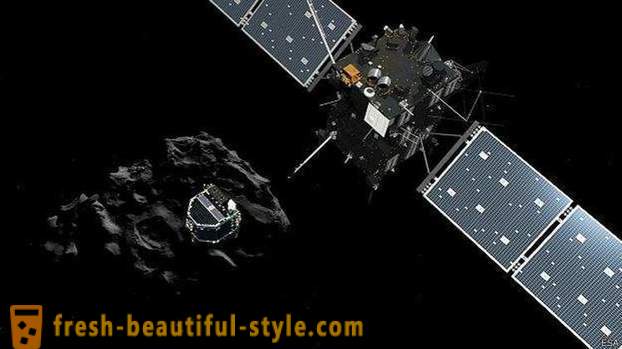
The probe "Rosetta" comet approached which must study, ten years after the start
The most notable event of the past year in the field of space exploration has become, without doubt, the European lander landing "Fila" (Philae) on comet 67P / Chyurumova - Gerasimenko. Shortly after landing, "Fila" ran out of battery charge and switched to standby mode. All this time the machine "wrote" about his impressions of the expedition in the "Twitter". His last record currently reads: "Soon will tell you more about my new home, comet 67P, hr-rr". ESA experts are hoping that the "Fila" awakened, when the comet approaches the Sun at a distance sufficient to recharge the battery from the solar cells.
Despite the short time of active work on the device surface 67P, the expedition has produced information that casts doubt on the accepted scientific theories, according to which the water is brought to Earth the comet. In addition, the probe "Rosetta", which is separated from the "Fila", remains in orbit 67P and performs its own body of scientific experiments.
The rover "Opportunity" (Opportunity rover)
The distance from Earth: 225 million kilometers
The time elapsed since the launch 11 years 5 months
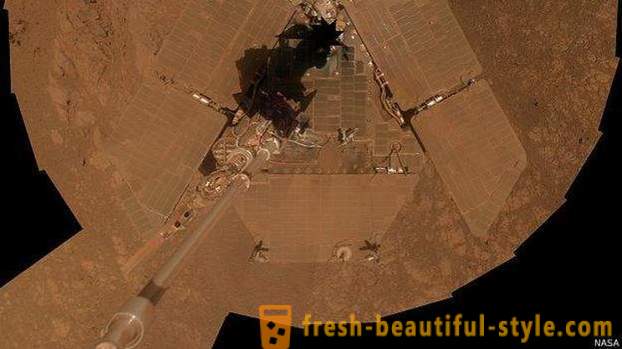
Opportunity "Mars proved himself a real" SUV "- safe and durable
Another active user space "Twitter" - an American rover "Kyuriositi", which reached the planet in the summer of 2012, - riveted the world's attention. On it is written, probably more material than all previous Martian machines combined. However, many unjustly forgotten one of his predecessors, who worked on the surface of Mars is much longer and is still in service.
Since landing on Mars in 2004, "Opportunity" covered a distance greater than 40 km, which is the unofficial record "run" for the Mars rovers. It is also a record for longevity, given that the device was designed for just one year of operation. Unfortunately, the twin brother of "Opportunity" rover "Spirit", worked only until 2010, but the performance of "Opportunity" - a good sign for "Kyuriositi".
The interplanetary station "Cassini-Huygens" (Cassini Guygens)
The distance from the earth 1, 2 billion kilometers
The time elapsed since the start of 17 years

The "Cassini-Huygens" check the general theory of relativity and found "lakes" on Titan
In January 2005, on the surface of Titan, one of Saturn's moons, down a tiny European probe "Huygens". The images that the device could transmit to Earth before sat onboard batteries, see the desert landscape under a veil of heavy methane clouds.
Although the "Huygens" has long ceased to work, the American station "Cassini", on board of which he reached the Titan continues to study Saturn and its environs.
the SOHO observatory
The distance from the earth 1, 5 million kilometers
The time elapsed since the start of 19 years

Although the project is called, as the bohemian district of London - Soho - he decides to serious scientific problems
Space observatory SOHO (Solar and Heliospheric Observatory) - a veteran of the solar observations. The device examines our luminary since 1995
SOHO is helping scientists better understand the nature of thermonuclear processes that take place inside a giant glowing ball, which is the sun. In addition, the Observatory daily data used for forecasting solar activity, including solar storms, which can have a negative effect on the equipment both on Earth and in its orbit.
Automatic probe "Voyager 1" (Voyager 1)
The distance from the Earth 19, 5 billion kilometers and increases
The time elapsed since the start: 37 years old

Voyager "Saturn made a snapshot and its moons in 1980, and in 2013 he left the solar system
Probe "Voyager 1", which is attached to the body of a gold plate, a message for extraterrestrial intelligence, is the most distant outpost of human civilization.
"Voyager 1" and his twin brother "Voyager 2" was launched back in 1977. The memory capacity of the onboard computer does not exceed 68 kilobytes. Both devices are equipped with radioisotope thermoelectric generators, already several times higher than the design life. After the "Voyager 1" in the last year has left the solar system, NASA renamed it into the interstellar station. Let these 12 space missions will serve as a reminder of the achievements in the field of space research for the past half century. Thanks to the tireless efforts of thousands of scientists and engineers, we can certainly count on the fact that our list will only spread over time.
Oh, and if you ever want to send a "Voyager" Happy New Year, it is advisable to do this in advance - the unit has flown so far, that the radio signal from Earth reaches it in 18 hours.













































